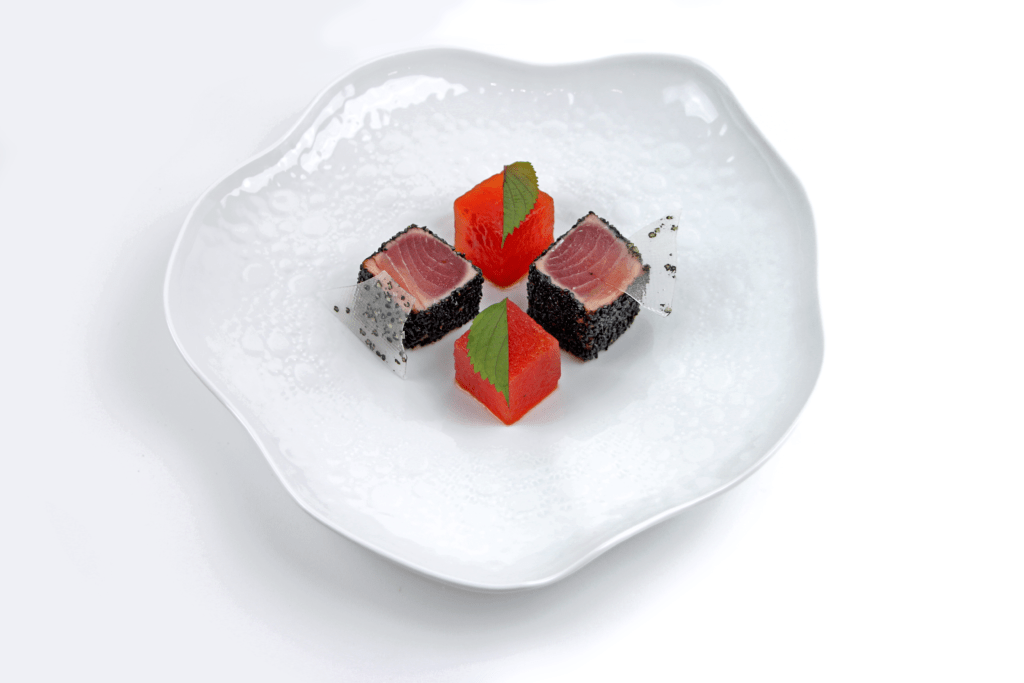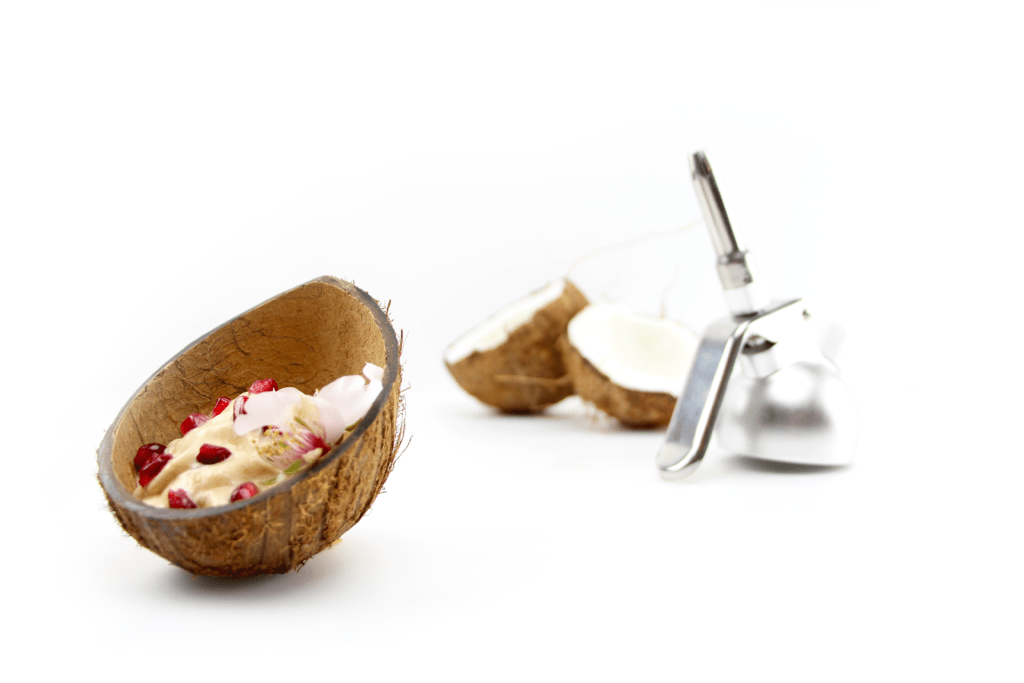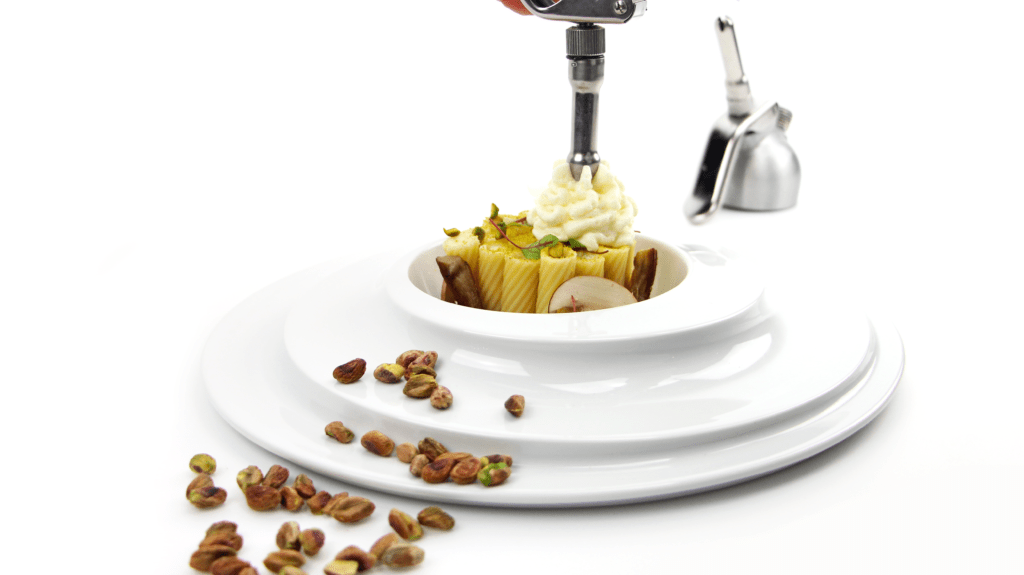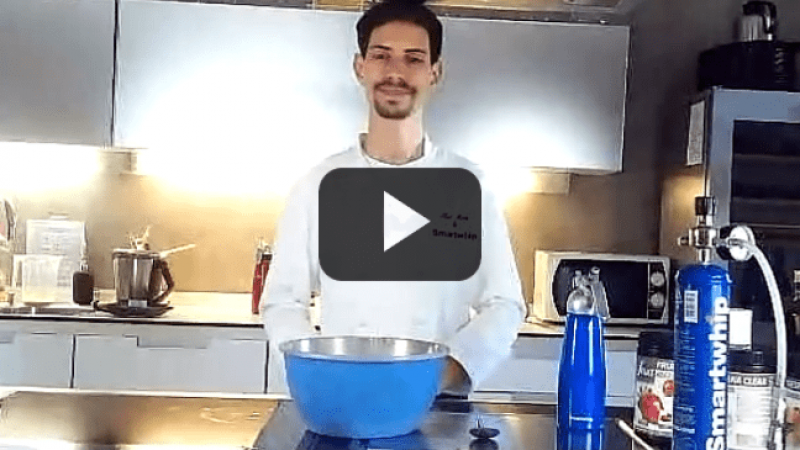Molecular Gastronomy Technique: Rapid Infusion
Kicking off the molecular gastronomy workshop, Rui gave a swift demonstration of the rapid infusion technique. While traditional infusions take anywhere from 24 hours to 2 weeks, a cream charger gets the job done in about 10 minutes.
Here are our key takeaways to keep in mind for rapid infusions:
-
- Don’t surpass the maximum filling capacity of the siphon.
- If you’re infusing olive oil, use extra virgin olive oil. If you’re using refined olive oil, leave it in the sous vide at 45°C for about 10 minutes. Doing so will infuse the oil with more flavour.
- Amp up the pressure for rapid infusions so that the oil can really penetrate the infusing ingredient and subsequently draw out the flavour.
- Infusing oil with N2O will help prevent the growth of mould and bacteria, which may occur with traditional infusion practices. This in turn extends the shelf life of the oil to 3 weeks or longer.

Molecular Gastronomy Technique: Marinating With A Siphon
The molecular gastronomy workshop continued with a salmon ceviche marinated in Leche de Tigre. Similar to the process of rapid infusion, the pressure of the N2O pushes the marinate deep into the meat fibres, cutting the marination time from a few hours to a mere 15 minutes. Not only is it quicker to marinade like this, but it also makes the meat more tender as the acidity of the marinade breaks down the protein fibres of the meat more effectively. Here are some things to keep in mind when marinating with a siphon:
-
- Just like with rapid infusion, marinating with a siphon requires high pressure, so we recommend using 17 bar.
- Cut your meat into small pieces (as opposed to putting the entire filet into the siphon), as this will increase the surface area for the marinade to do its magic.
- While ceviche is a raw dish, the high acidity and low pH levels from the lime and lemon in the Leche de Tigre change the structure of the proteins in the fish, essentially cooking the meat without using heat.
- Give the siphon a good shake before placing it in the fridge to marinate. This is necessary to ensure that the liquid and N2O is well dispersed.

Molecular Gastronomy Technique: Cold Foam
To accompany the salmon ceviche, Rui made a velvety wasabi foam with coconut milk. The reason for adding foam is multifold: it makes the recipe more aesthetically interesting, mildens the flavour of the wasabi, and adds a velvety texture that contrasts the meaty salmon and mango. This molecular gastronomy workshop emphasis that when creating this (or any) foam recipe, there are a few things to keep in mind:
-
- Foams don’t require as much pressure as rapid infusions and marinades. Generally, 10-12 bar on the Smartwhip cream charger is sufficient. If you’re using disposable N2O capsules, note that each capsule is equivalent to about 4 bar.
- You need fat for any foam as N2O dissolves best in fatty substances. For this recipe, Rui used full-fat coconut milk.
- A foam also requires protein to bind the air bubbles and stabilise the foam. If your recipe does not have any protein, you can add in the form of an additive, such as albumin.
- If your recipe is very runny, consider adding a thickener as this will result in a more voluminous foam. Rui likes to use Sosa products such as the hot and cold proespuma. These products contain several additives and are perfect if you’re crunched on time or just need a lazy recipe. Alternatively, you can use targeted additives depending on what your recipe requires.
- To avoid clogging the siphon, use a sieve to strain the foam mixture into the siphon–even egg fibres can jam a siphon.
- Shake the siphon well to evenly distribute the N2O.
- Use chilled ingredients and place the siphon in the fridge for at least 10-15 minutes before serving, as N2O becomes more soluble at low temperatures.
- If it’s your first time making a foam, play around with releasing the foam first to get a feel for how much pressure you should put on the lever.

Molecular Gastronomy Technique: Hot Foam
Next up, was a hot foam demo. For this molecular gastronomy workshop, Rui chose to make a seafood foam, with cream and eggs acting as emulsifiers. The preparation process is pretty much the same as that of any other foam, but there are a few things to consider when making a hot foam:
-
- Xanthan gum is a great thickener for hot foams as it works at both hot and cold temperatures, and it can be added to pretty much any recipe. Just use a good blender to ensure it’s well dissolved.
- If you’re planning on leaving the foam in a water bath (sous vide), consider the time and temperature requirements of different ingredients. Generally, you want to maintain the foam at the temperature you want to serve it at. But for some recipes, such as hollandaise sauce, you need to be careful not to exceed the maximum temperature (in this case 74°C), otherwise, you risk curdling the sauce.
- If you want to keep the hot foam in the sous vide throughout the service, keep the temperature between 55-60°C.

Molecular Gastronomy Technique: Nitro-Poached Solid Foam
The molecular gastronomy workshop ended with a nitro-poached vodka and matcha foam. An adaptation from Heston Blumenthal’s original recipe, this recipe works great as a palate cleanser. Using liquid nitrogen and fruit pectin as a gelling agent, you can instantly freeze foam, leaving behind a solid foam. Our tips for mastering this kind of solid foam:
-
- Use fruit pectin as a gelifier and palate cleanser. It thickens the recipe, giving the foam a better structure, and simultaneously cleanses the palate.
- Use pasteurised lemon to stabilise the flavour and increase the longevity of the foam. While N2O already helps increase the lifetime of a foam, pasteurised lemon ensures that the flavours remain just the way you wanted them.
- Adding alcohol furthermore removes the volatiles from the tongue and cleanses it so that your taste buds can once again determine the flavour of the next food or drink unhindered.
As we look back at our second molecular gastronomy workshop, we are reminded of how much flexibility a cream charger can bring to the kitchen workflow. And that’s what Smartwhip is all about–inspiring, enabling and supporting Chefs on their culinary ventures.
Have you already taken the Smartwhip system for a test drive? Tilaa omasi täältä and explore new cooking techniques using a cream charger.


